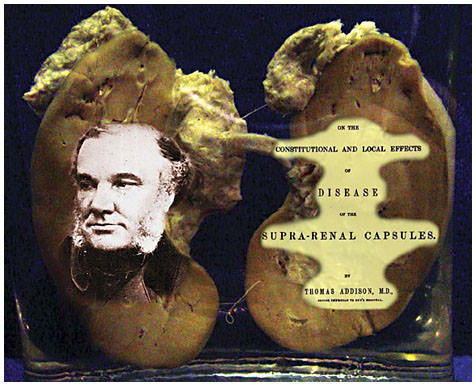The doctor who first described appendicitis: Who is Thomas Addison?
He described the deadly form of anemia named after him: Until his work was published, almost nothing was known about the adrenal glands. He is considered the founder of endocrinology.

(1793-1860) English physician. He described the deadly type of anemia and adrenal gland disease named after him. He is considered one of the founders of endocrinology. He was born in April 1793 in Long Benton, a coal town. After receiving his diploma as a specialist physician from Edinburgh University, where he studied medicine, in 1815, he settled in London and worked in various hospitals. Despite being a specialist physician, he was not satisfied with the experience he gained and started his education at Guy's Hospital again in 1820. He devoted himself to his research in this hospital, where he was appointed an assistant in 1829 and a physician in 1837. Addison, who had to leave his job in the early 1860s due to his deteriorating health, died on 29 June in Brighton, where he went to hope for recovery.
Thomas J Addison (April 1793 – 29 June 1860) was an English physician, chef, and scientist. He is traditionally regarded as one of the "great men" of Guy's Hospital in London.
A careful researcher and a good teacher, Addison examine the effects of poisonous substances on living things in the first of his few but important works; He first described appendicitis in The Elements of the Practice of Medicine, published in 1839. His reviews of lung inflammation (pneumonia), pulmonary tuberculosis, liver enlargement, and various skin diseases were published in medical journals at different times and were collected under the name of A Collection of the Published Writings of the Late Thomas Addison (1868). In his report to the London Medical Association in 1849, Addison drew attention to a deadly type of anemia, beyond what had been known up to that time. In the autopsy he performed on those who died of this disease, he also encountered the symptoms of adrenal gland disease. Concentrating his research on this issue, he defined the types of diseases that would later be called "Addison's disease" and "Addison's anemia". He explained his findings in this area in his work, On the Constitutional and Local Effects of Disease of the Supra-renal Capsules, published in 1855.
In the preface to this book, Addison gave a general definition of the disease he called "anemia of unknown origin", but could not specify its causes. This is due to the fact that the use of microscopes was very new at that time, and that the structure of the blood was not sufficiently known. The Swiss Anton Biermer, who later worked on the same subject, described the disease, which he described for the first time, as "deadly anemia" in 1872. Due to his contributions to this issue, the disease is also called by the name of Biermer. Anemia is manifested by jaundice, lack of gastric juice, and advanced digestive and nervous system disorders, which are caused by the breakdown of blood cells and platelets. As a result of the developments at the beginning of the 20th century, it was determined that the disease was largely caused by vitamin B deficiency. Particularly, as a result of the deficient production of the enzyme, which helps to assimilate this vitamin from food, by the cells of the stomach wall, vitamin B deficiency in the organism leads to irregularity in DNA production, which leads to the enlargement of red blood cells in the bone marrow. While most of these giant cells, called megaloblasts, disappear without joining the bloodstream, some of them enter the bloodstream (macrocyte or megalocyte) and cause disease. This disease, which is mostly seen in middle-aged people who have had stomach ulcers, stomach cancer, or had their stomach removed, lost its lethal quality with vitamin B12 treatment.
In the same work, Addison defines "Addison's disease", also known as "adrenal insufficiency". Anemia, weakness, weight loss, weakening of the heartbeat, tenderness of the stomach, and darkening of the skin color are the main symptoms of the disease. Addison found that in each of the eleven autopsy specimens he examined, the adrenal glands were injured and that three-quarters of these injuries were caused by tuberculosis. Indeed, a developmental disorder such as scab recession or wounds resulting from tuberculosis leads to a deficiency of vital steroid hormones. For the treatment of the disease, this deficiency must be corrected first.
Almost nothing was known about the adrenal glands until Addison's work on the subject was published. The functions of the endocrine glands, especially the adrenal glands, began to be studied after this date. Addison is considered the founder of endocrinology because he was the first physician to draw attention to the relationship between pathological changes in the endocrine glands and the symptoms of the disease.
WORKS:
- An Essay on the Operation of Poisonous Agents upon the Living Body, 1829,
- The Elements of the Practice of Medicine (with R. Bright), 1839,
- On the Constitutional and Local Effects of Disease of the Supra-renal Capsules, 1855,
- ACollection of the Published Writings of the Late Thomas Addison, (d.s.), 1868.
